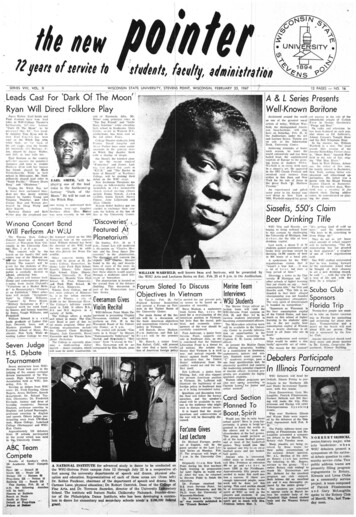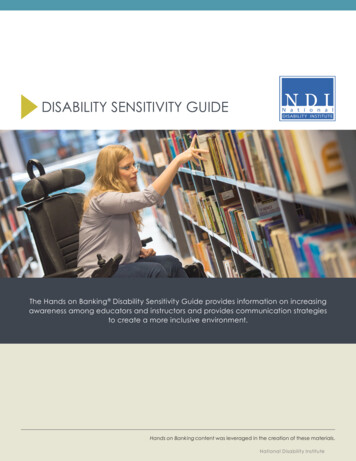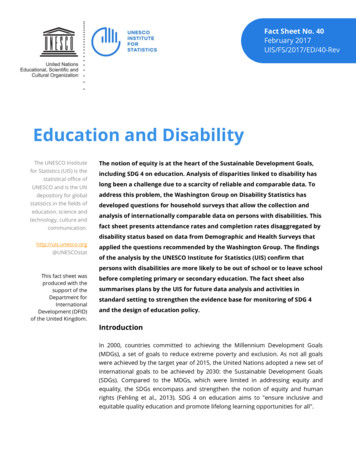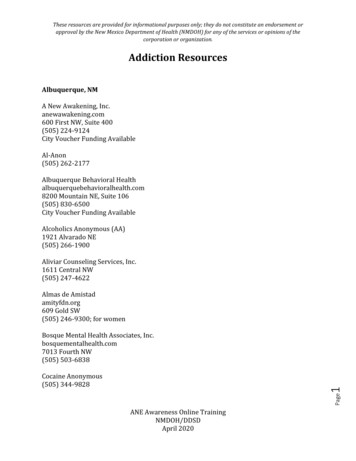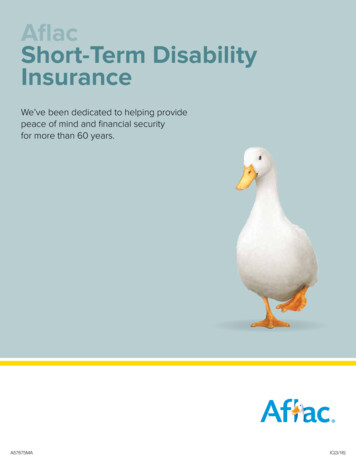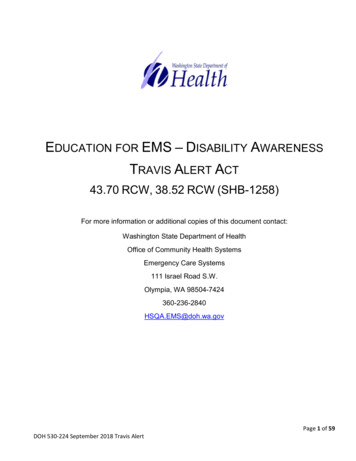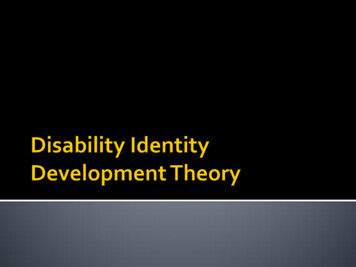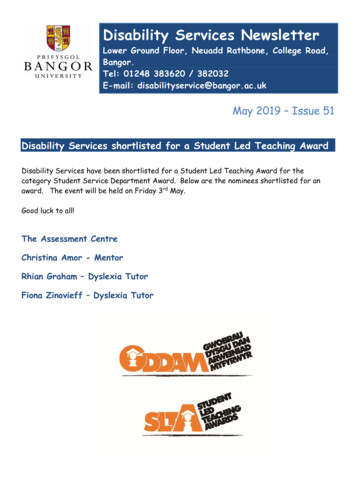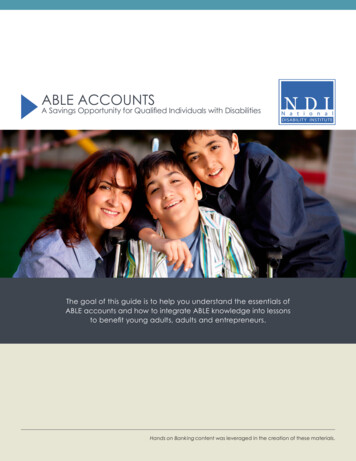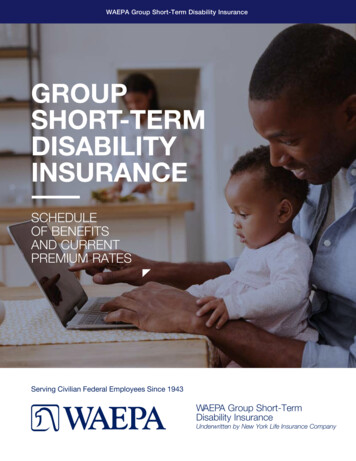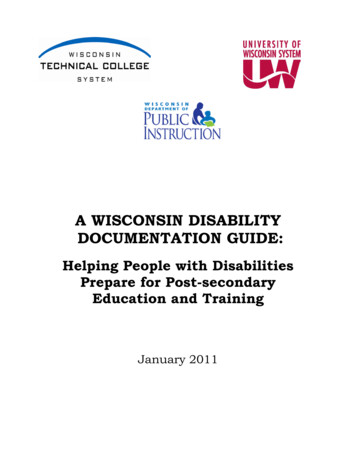
Transcription
A WISCONSIN DISABILITYDOCUMENTATION GUIDE:Helping People with DisabilitiesPrepare for Post-secondaryEducation and TrainingJanuary 2011
The Wisconsin Technical College System (WTCS) is in compliance with stateand federal equal opportunity and affirmative action laws and regulationsincluding Title VII of the 1964 Civil Rights Act, the Age Discrimination inEmployment Act, Title VI of the 1964 Civil Rights Act, the Equal Pay Act of1963 as amended, Title IX of the 1972 Education Amendments, and Section 504 ofthe 1973 Rehabilitation Act, the Wisconsin Fair Employment Law, the Office ofCivil Rights Vocational Education Program Guidelines for the Elimination ofDiscrimination and Denial of Services on the Basis of Race, Color, NationalOrigin, Sex and Handicap, the Americans with Disabilities Act, and otherapplicable state or federal legislation. It is the policy of the WTCS not todiscriminate by reason of age, race, creed, color, disability, marital status, sex,national origin, ancestry, sexual orientation, arrest record, conviction record,membership in the National Guard, state defense force or any other reservecomponent of the military forces of the United States, or this state or use ornonuse of lawful products off the employer's premises during nonworking hours.Inquiries regarding equal opportunity may be directed to the Wisconsin TechnicalCollege System, P.O. Box 7874, Madison, Wisconsin 53707-7874; telephone(608) 267-9745 or Telecommunications Device for the Deaf (TDD)(608) 267-2483. Internet: www.wtcsystem.edu.For inquiries about this guide please contact:Thomas HeffronEducation DirectorDisability Services / Financial AidWisconsin Technical College (WTC) System Office4622 University AvenueP.O. Box 7874Madison, WI 53707-7874ORFor an electronic copy, please access one of the following websites:WTCS: alresource/disabilitiesR.htm,Wisconsin Department of Public Instruction (DPI): http://dpi.wi.gov/sped/transition.html,
or Wisconsin Statewide Transition Initiative (WSTI): http://www.wsti.org.ACKNOWLEDGMENTSThe Wisconsin Guide to Disability Documentation was developed and composed by theWisconsin Disability Documentation Workgroup in 2003, and updated in 2010. The Workgroupwas comprised of K-12 special educators, Cooperative Educational Service Agency (CESA)representatives, and Disability Services staff from the University of Wisconsin, WisconsinTechnical Colleges, and Wisconsin Independent Colleges.The Wisconsin Department of Public Instruction (DPI) and the Wisconsin Technical CollegeSystem (WTCS) office thank the following workgroup members for their expertise anddedication:Colleen Barnett, Alverno College, Student Accessibility CoordinatorPatti Brandt, CESA 6, Transition CoordinatorAaron Czappa, Chippewa Valley Technical College, Learning Support SpecialistSteve Gilles, DPI, Consultant - Transition ServicesSherry Gundlach, CESA 6, Wisconsin Statewide Parent-Educator Initiative(WSPEI) CoordinatorRivian Hatt, Lakeshore Technical College, Learning Support CoordinatorTom Heffron, WTC System Office, Education Director, Disability Services andFinancial AidElizabeth Kennedy, Sauk Prairie School District, Transition CoordinatorJennifer Ledin, CESA 12, Transition CoordinatorBruce Rathe, Fox Valley Technical College, Special Needs Support InstructorCarol Spain, Milwaukee Area Technical College, Manager, Assessment andInterpreting ServicesCathy Trueba, University of Wisconsin-Madison, Director, McBurney DisabilityResource Center
Table of ContentsSection I .1Introduction / Disability Documentation.2Section II .4Summary of Applicable Laws . 5-9Section III . 10Disability Documentation: What is it and How is it Used? . 11-14Section IV. 15Obtaining and Providing Disability Documentation . 16-17Frequently Asked Questions About Obtaining and Providing Disability Documentation . 18-19How Do I Obtain Documentation of a Disability? .20Section V . 21Elements of Documentation by Disability .22Table I - Summary of Disability Impairments & Categories . 23-25Table II - Post-secondary Disability Categories with Contents of Documentation,Qualifications of Persons Diagnosing, and How Recent Documentation Must Be . 26-31Table III - Functional Limitations & Supporting Evidence for Post-secondary DisabilityCategories . 32-40Section VI. 41Websites for Disability Documentation Information at Wisconsin Colleges andUniversities. 42-44Section VII . 45Resource Websites . 46-49Appendices . 50-51Summary of Performance. 53-58Kenosha Unified School District Example - Seamless Collaboration of Post-SchoolTransition Planning for Students with Disabilities . 59-60Acronyms Used in This Guide . 61-63
Section I1
I.Disability DocumentationIntroductionThis Guide is a revision of the original Wisconsin Post-secondary Guide to DisabilityDocumentation that was completed and disseminated statewide in 2003-04. At that time,Wisconsin educators in pre K-12 and post-secondary institutions, as well as disability servicesprofessionals in state agencies serving students, had expressed a need for guidance related todocumentation of disability for adolescents and adults continuing their education after highschool. Due to changes in federal legislation and in response to feedback about the originalGuide, the workgroup was reconvened in 2009 with representatives from K-12 special education,CESAs, disability services offices of the Wisconsin Technical Colleges (WTCS), University ofWisconsin campuses, and Wisconsin Independent Colleges, the WTCS office and the WisconsinDepartment of Public Instruction (DPI).This document is a guide, not a state policy or set of mandated procedures.Documentation is a critical element in providing access for students with disabilities to postsecondary education. Currently, however, there are no federal standards ondocumentation of disability at the post-secondary level. Documentation requirementsand practices are determined by individual post-secondary education institutions. Inaddition, procedures, guidelines, and practices for documenting disabilities and establishingappropriate accommodations for students may vary from school district to school district.This guide will assist all partners involved in transition to understand disabilitydocumentation and determine their roles in assisting students with disabilities. As revised,the guide is intended to improve the quality and usefulness of documentation of students'disabilities and to create improved communication between all transition partners: studentswith disabilities and their parents/families, and K-12 school, post-secondary education andstate agency representatives. This guide may also be useful in the development andimplementation of institutional policies.Key issues related to documentation the Guide seeks to address include: There are critical differences between institutional laws and policies affecting high schoolstudents with disabilities as they exit from high school and enter post-secondaryeducation programs.One difference in particular that affects smooth transition is that post-secondaryinstitutions require current relevant data on a student's disability.Data must include formal documentation, including history of services, evidence offunctional limitation, names of assessment tools administered, results tied to previoustreatments, and recommended accommodations.Depending upon a student's chosen program of study, added documentation may beneeded for state and national certification, such as passing state board exams or licensure2
requirements (for example, GED/HSED, nursing, teaching, fire fighting, EmergencyMedical Technician, and the State Bar).Adding further complexity to the process is the fact that post-secondary institutions donot have common practices and requirements for documentation of disabilities.Due to differences in laws, the role and responsibilities of students with disabilities shiftas they transition into post-secondary institutions. They have greater responsibility fordisclosing their disability, providing documentation, communicating with disabilityservice personnel and advocating for their needs.Yet students with disabilities, their parents, secondary teachers, and counselors often lackinformation about post-secondary documentation criteria. As a result, students may nothave appropriate documentation when they enroll in post-secondary education.Students with disabilities, although required to leave high school with clear post-schoolgoals and plans, often exit school with limited self-advocacy skills. They sometimes donot know specific post-school contacts, or do not communicate information needed fordocumentation at the post-secondary school.Students must know what their disabilities are and what accommodations have been usedto address them. They also must be able to communicate and/or document their disabilityand needed accommodations.Students with disabilities need to be prepared to communicate their summary of academicachievement and functional performance listed on the Summary of Performance (SoP) tosupport appropriate documentation when they enroll in post-secondary education.High schools need to assist the student with disabilities to develop a meaningful SoPprior to leaving school.High schools use different kinds of testing, practices, and documentation to collect andcommunicate information about students. They may also use existing data as part of theevaluation process to determine continuous eligibility for special education services.There is confusion about the distinctions between the Individuals with Disabilities Act(IDEA) and Section 504 (§504) of the Vocational Rehabilitation Act 73 for K-12educators.The individual post-secondary institutions are responsible for establishing and implementingtheir disability documentation criteria and procedures.Users of this guide may make copies and utilize all or part of the document toassist the disability documentation process.3
Section II4
II.Summary of Applicable LawsAs students go through the transition process from high school to post-secondary education, it isimportant for them and for those working with them to understand the differences and changesrelated to federal and state law that impact availability of services for students. There are threeprincipal federal laws which affect individuals with disabilities transitioning from high school topost-secondary environments of work and/or education. In addition, there are state statutes whichhave an impact on this group.The Individuals with Disabilities Education Act (IDEA) provides special education servicesto students in public schools. It funds some of the expenses of educating students withdisabilities and spells out specific duties, tasks, and services that must be provided. Section 504(§504) of the Rehabilitation Act and the Americans with Disabilities Act (ADA) are alsofederal laws. However, they apply to society as a whole, not just K-12 students in public schools.They do not typically have funding associated with them and they do not guarantee specificservices or programming for people.5
IDEA funds special education programs and states what MUST be doneand MUST be provided for students with disabilities in K-12 schools(referral, evaluation, and individualized programming).Section 504 and Title II of the ADA are federal non-discrimination lawsand do not provide funding. These laws state how qualified individualsMAY NOT, ON THE BASIS OF DISABILITY, 1. be excluded fromparticipation, 2. be denied the benefits, or 3. otherwise be subject todiscrimination in schools, employment, and the community.IDEA Is an entitlement programApplies to childrenApplies to K-12 educationUsually covers certain specific disabilities with an educational impactGuarantees certain benefits and servicesSection 504 and the ADA Are civil right laws, not specific programs Applies to anyone, not just students Applies to federally funded entities as well as businesses and employers Cover most impairments, with or without an educational impactIDEA is the federal special education law. Initially passed in 1975, it places an affirmativeobligation on school districts to locate, identify, and serve children with disabilities from ages 3through 21 or high school graduation. IDEA provides federal funding to schools to provideservices to children with disabilities.One of the purposes of IDEA 2004 is to ensure that students have a free and appropriateeducation that emphasizes special education and related services in relation to individual needsand preparation for further education, employment and independent living opportunities. Theterm transition assessment was added directly for the first time under the IndividualizedEducation Program (IEP) requirements in 2004. Transition assessment is an important part of theeducational process for students with disabilities during the secondary school years and serves asthe foundation for planning for adult roles. Transition assessment includes age appropriatemethods to assist students in identifying individual needs, strengths, preferences, and interests.Transition assessment also incorporates obtaining information on future living, work, andeducation environments. Measurable post-secondary goals must be based on age appropriatetransition assessments. Transition assessment does NOT necessarily mean diagnosis or formaldocumentation of disability, but it could per student request.6
IDEA applies only to individuals who meet the criteria for one or more specific conditions orimpairments and who, because of the impairment, require special education and related services.Special education is specially designed instruction to meet the unique needs of an individual witha disability. Identification of eligibility is made by a group of people including the parents oradult pupil, special education teacher(s), regular education teacher(s) and others with knowledgeof the individual. There are procedural safeguards to protect the rights of these persons andensure school compliance with the obligations established by IDEA.School districts are required to provide a free appropriate public education (FAPE) to each childwith a disability. FAPE is defined by the IEP, which must be reviewed and revised at leastannually. The IEP contains measurable annual goals, with short term objectives and benchmarks,a statement of the special education and related services to be provided to the child, andbeginning at age 14 (based on Wisconsin state law), statements relating to transition to life aftersecondary school.Wisconsin law incorporates the provisions of IDEA at Subchapter V of Chapter 115. State lawnearly mirrors federal law. IDEA and state special education law are enforced by the DPI.The role of parents and families is critical in understanding the law and assisting the child inthe transition process, which is about preparing for life as an adult. Parents with their child areessential in transition planning. Parents as well as their child should contribute to transitionassessments. Parents should talk with their child about their strengths, preferences andinterests, parents and youth can help the rest of the IEP team identify meaningful measurablegoals that the students would like to achieve after high school. Parents should encourage theirchild to attend and lead the IEP team meeting to share as much as possible their vision/dreams for the future including interact and preferences.IDEA was reauthorized on December 3, 2004, and its provisions became effective on July 1,2005. In conjunction with the reauthorization, the U.S. Department of Education through theOffice of Special Education Programs required states to develop six-year State PerformancePlans in December 2005, around 20 indicators. Beginning February 2007, and each subsequentyear, data on the indicators is submitted by states in Annual Performance Reports.The 13th performance indicator relates to transition requirements within the IEP, includingmeasurable post-secondary goals based on age-appropriate transition assessment, course ofstudy, coordinated set of activities, and involvement from outside agencies. Indicator 13 requireslocal school districts to implement these transition requirements of the law related to the IEP.This guide can assist students and teachers in meeting the measurable post-secondary goalswritten for the student in education or training.All schools in Wisconsin must review IEPs for indicator 13 as part of the self-assessmentmonitoring process that is verified and reviewed by the special education team of the DPI. Thereis a review cycle in which one-fifth of the districts participate in the self-assessment each year.Corrections and action plans must be implemented by local school districts if they identify anystudent-specific noncompliance.7
The 14th performance indicator relates to Post-High School Outcomes, specifically thepercentage of youth with disabilities who go on to post-secondary education or are competitivelyemployed after leaving high school. The Wisconsin Post-High School Outcomes Survey(WPHSOS) assesses the outcomes of individuals with disabilities one year after they have exitedhigh school. Former students are contacted for a telephone interview to assess independentliving, participation in post-secondary education, employment, and high school IEP planning.Each Wisconsin school district must demonstrate fulfillment of the requirements of Indicator 14of the State Performance Plan to the DPI once during a 5-year period, similar to the cycle usedfor Indicator 13. In addition to using the WPHSOS website in a compliance year, districts maychoose to use the website any year to collect outcomes data on local exiters.IDEA requires local education agencies (LEAs) to provide a "summary of academic achievementand functional performance" for students with disabilities
Education Program (IEP) requirements in 2004. Transition assessment is an important part of the educational process for students with disabilities during the secondary school years and serves as the foundation for planning for ad
